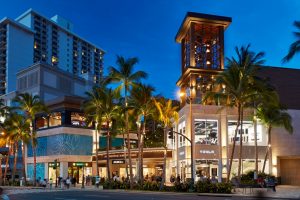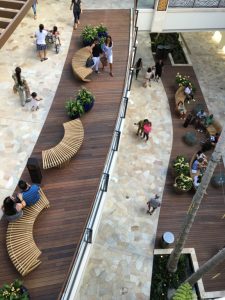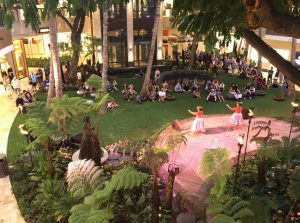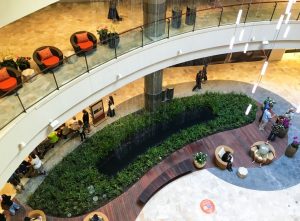The Merriam-Webster Dictionary defines “engaging” as tending to draw favorable attention or interest. The first tenet of retail, dating back to the early merchant princes of the past century, was enticement – i.e., attract them into the store. The tools of enticement back then ran the gamut of everything from art and architecture to advertising and air conditioning. Now, perhaps more than ever before, retailers must entice the targeted customer back into the store.
However, the allure mustn't end at the front door, it must continue on a defined journey map with strategically positioned points of engagement along the way. As we reconsider the traditional role of the store (get them in, sell something and get them out), we must shatter consumers’ expectations at every turn. And yes, the early merchants did in fact engage with grand fountains, imposing sculptures and dynamic architectural statements that were theirs and theirs alone.
Engaging the community took on epic proportions in the early days of the American department store. In Philadelphia, the local denizens would meet at Wanamaker’s majestic eagle statue positioned strategically in the center of the main floor. This was so much a part of Philadelphia’s DNA that to this day, its NFL team bears the name “The Eagles.” In New York, people rallied around Siegel and Cooper’s palatial fountain with its spectacular jets of colored light and water. Not only did Siegel, Cooper and Co. become part of the community, but “I’ll meet you at the fountain” became part of the New York lexicon. Whether they were businessmen, friends or lovers; meeting at the fountain was a great tool of engagement and community connection for what was then the largest department store in the world.
Today we can still learn from the philosophies of those early merchandising pioneers. But, of course, times have changed. Now, in addition to understanding engagement and enticement, we must take it a step further and understand movement and attention span.
On a recent summer getaway to Colorado, I had the opportunity to walk the Pearl Street Mall in Downtown Boulder. The outdoor pedestrian shopping center runs along Pearl from 11th to 15th Streets. Carl Okazaki, partner at 505 Design in Boulder, who was involved in the design and development of the mall during his time at Communication Arts, said, “Having explored retail projects and neighborhood districts across the country, we find that it's difficult to energize a pedestrian corridor. The scale, density and pedestrian circulation of projects significantly impact the customer experience.”
Okazaki, along with James McCandless, director of strategic partnerships, and Todd Cail, project team leader at Design 505, said that scale and memorable points of interest were essential to the success of any strategic repositioning. According to the design team, four-to-six blocks is the ideal size for a downtown retail district. Much smaller and it wouldn't have enough critical mass to become a destination and if it were much larger, it would become a watered down experience, as the various retail uses start to become somewhat repetitive. They also spoke of the efficacy of signature features (rock water feature, rock playground, pop-jet fountain, animal sculptures) strategically positioned on each block to create a draw to pull customers along.
Advertisement
Design 505 also includes the design of the International Market Place (IMP) in Waikiki in their portfolio. Here the same approach to scale and interest applied. Ironically, as the site offered historical challenges, it also offered unique opportunities to engage the visitor. Loved by locals and visitors alike since it first opened in 1956, the International Market Place was a magnet to entertainers visiting the islands, and a regular venue of favorite son Don Ho, who loved to perform there. In May of 2010, work began on the reinvention of the space with a grand opening in 2016.
Due to the historic significance of the site, the design team searched for a balance between memory and prophecy, embracing the rich heritage of the site while translating those qualities in a fresh and contemporary way that resonates with modern lifestyles. Okazaki said, “We wanted the project to embody its location and reflect the local culture, while still resonating with visitors.” To achieve this, the team distilled its mission statement to three guiding principles.
-
Perpetuate the legacy of Queen Emma of Hawaii, whose mission was to provide in perpetuity quality healthcare for native Hawaiians and the people of Hawaii.
-
Celebrate the history of the land on which the property sits, Kaluaokau, and its people.
-
Revitalize the International Market Place as the signature gathering place in Waikiki and a world-class destination for retail, entertainment and culture.
The resultant design strategy called for the strategic positioning of distinct points of engagement throughout the journey to enhance the customer experience. The Fire Tower is a modern interpretation of a lamaku, a torch-lit coastal beacon used to fish at night. This was seen as a beacon along Kalakaua, the main pedestrian thoroughfare in Waikiki, with its tiki torch chandelier providing a nod to the property’s nostalgic roots.
Continuing along, the Tree House was inspired by a treehouse that actually existed on site. It was originally used by Don Beach (original founder of IMP) as his office and later served as a studio for a local radio station. The treehouse design, from its parabolic roof and curved bridges, was all intentionally done to create the effect of the structure floating within the tree canopy. There were also interpretive sign panels incorporated into the structure to celebrate the history of the iconic entertainers who performed at IMP.
The Queen’s Court honors the legacy of Queen Emma, whose mission was to provide, in perpetuity, healthcare services to improve the well-being of native Hawaiians and all of the people of Hawaii. This feature includes The Queen's Garden, which highlights native medicinal plants; statues in remembrance of the Queen and her husband (King Kamehameha IV Liholiho) and son (Prince Albert); an elevator tower covered with graphics of the Queen's mele (poetry); and a celestial water table inspired by the celestial navigation charts used by Hawaiian voyagers.
Landscaping was used in two ways; as points of engagement and to maintain the historical integrity of the space. Existing landmark banyan trees and other significant canopy trees drove the massing for the project as they were maintained as key focal points of engagement. Additionally, the courts and terraced concourses were designed to open up as the visitor rose vertically to accommodate the tree canopies and to maintain a visual connection between the Grand Lanai (roof deck) and the ground plane. Okazaki said, “We were very conscious of making the building feel layered and changed the application of materials and textures on the building so it felt more anchored at the ground level (lava rock, coral stone, basalt) and lighter on the upper floors (wood, trellis canopies, patterned metal panels).”
Advertisement
Today, a journey through any brick-and-mortar retail space must be akin to scrolling through a retailer’s website. But when customers cross the threshold of a store, give them more than cyberspace can offer, shatter their expectations. Take them on a journey to another place and perhaps another time. Entice them and engage them as they go beyond the lease line. Understand and employ the rules of engagement.
Eric Feigenbaum is a recognized leader in the visual merchandising and store design industries with both domestic and international design experience. He served as corporate director of visual merchandising for Stern’s Department Store, a division of Federated Department Stores, from 1986 to 1995. After Stern’s, he assumed the position of director of visual merchandising for WalkerGroup/CNI, an architectural design firm in New York City. Feigenbaum was also an adjunct professor of Store Design at the Fashion Institute of Technology and formerly served as the chair of the Visual Merchandising Department at LIM College (New York) from 2000 to 2015. In addition to being the Editorial Advisor/New York Editor of VMSD magazine, Eric is also a founding member of PAVE (A Partnership for Planning and Visual Education). Currently, he is also president and director of creative services for his own retail design company, Embrace Design.


 Photo Gallery1 week ago
Photo Gallery1 week ago
 Headlines7 days ago
Headlines7 days ago
 Headlines1 week ago
Headlines1 week ago
 Headlines2 weeks ago
Headlines2 weeks ago
 Headlines1 week ago
Headlines1 week ago
 Designer Dozen2 weeks ago
Designer Dozen2 weeks ago
 Designer Dozen5 days ago
Designer Dozen5 days ago
 Headlines7 days ago
Headlines7 days ago




















